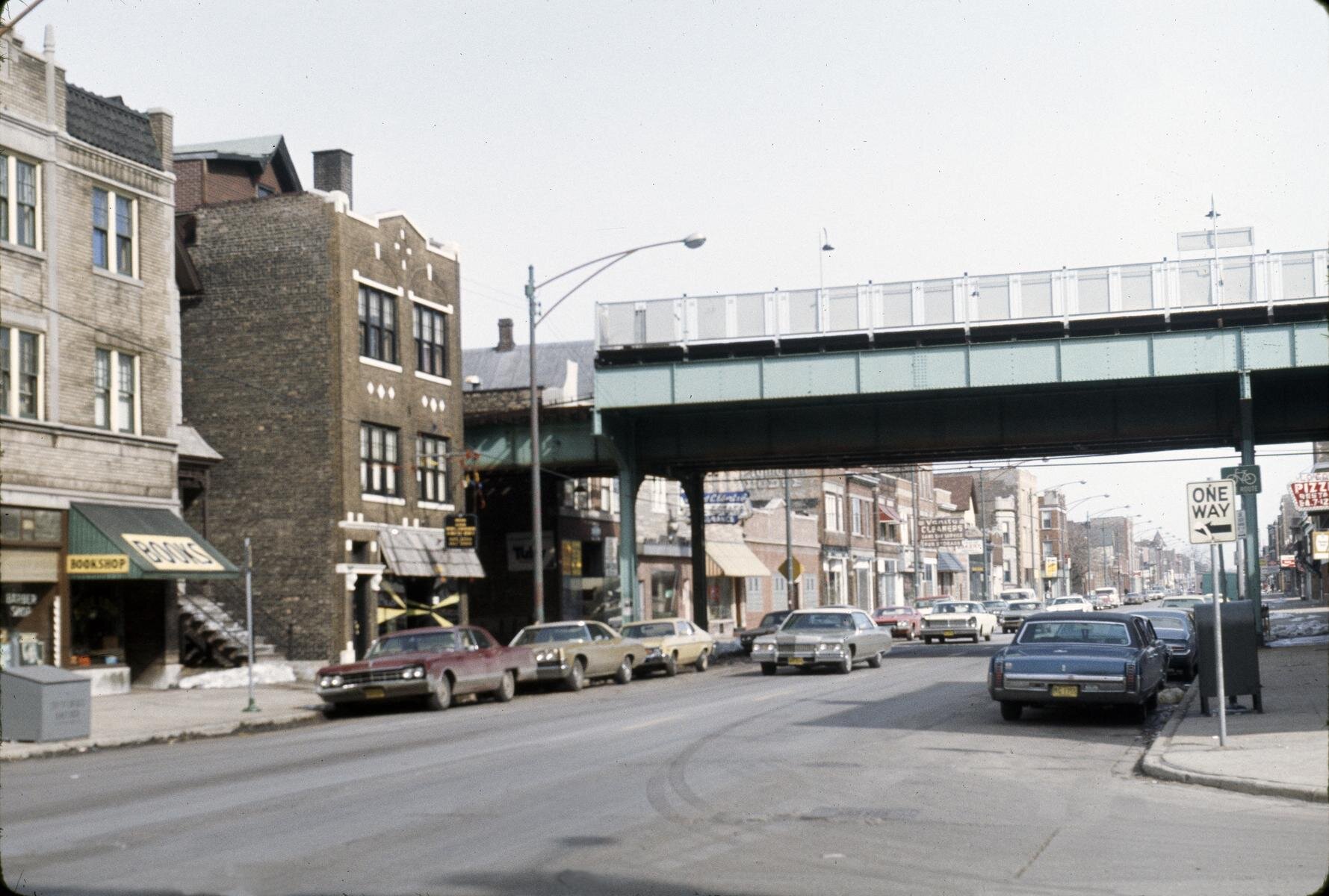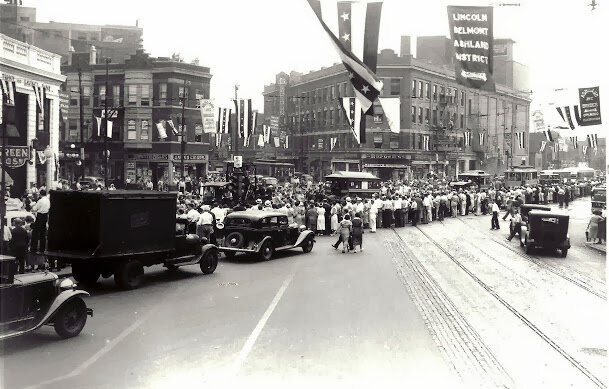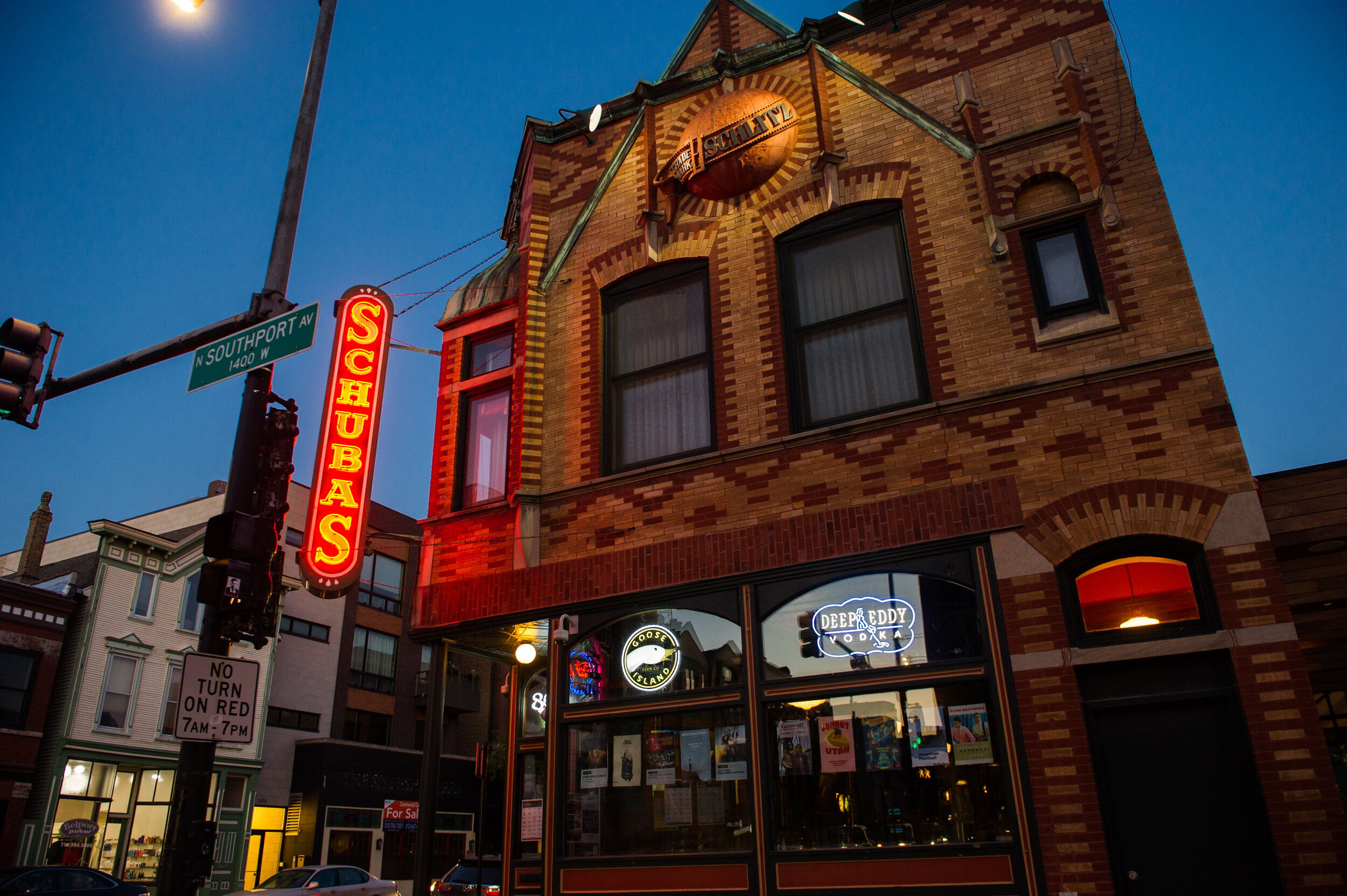
History
Pictured Above: The Southport Corridor in the 1970s. (Photo: Explore Chicago)
Lakeview
Chicagoans in the 19th century poured north into Lakeview, an agricultural region known as America's celery capital. The newcomers turned truck farms into suburban subdivisions, incorporating as a city in 1887. Lakeview couldn't make it on its own, and voted to join Chicago after two years of independence. The voters were "fools," Lakeview's mayor said, but it was done.
Lakeview grew into a prosperous industrial neighborhood, with factories on Diversey Parkway and along the railroad that ran down Lakewood Avenue (you can still see traces of tracks). A few old businesses survive. Monastery Hill Bindery, founded by a German immigrant before the Fire, along with Dinkel's Bakery, are some of the reminders of Lakeview's German community.
By the 1970s, Lakeview boasted an unusual and shifting population. Old families of German and Swedish stock were joined by American Indians, Southerners, Hispanics, gays, hippies and Japanese Americans. Restaurants like Zum Deutschen Eck co-existed with hillbilly joints, folk bars, taquerias and drag queens. Somehow it all worked.
Lakeview started switching names regularly, a sure sign gentrification was coming. New Town, Wrigleyville, Boystown, Belmont Harbor, Graceland West: Some labels stuck and some didn't. Lakeview grew into the neighborhood it is today, a fashionable urban locale with a deep history and a future yet to be written.
The intersection of Lincoln Ave., Ashland Ave., and Belmont Ave. in the late 1930s. This brief history of Lake View is based on the book "Lake View," by Matthew Nickerson. (Photo: Calumet 412)
Aladdin's Castle at Riverview Amusement Park. Learn more about the legacy of Riverview Amusement Park in this interactive feature from WBEZ. (Photo: WBEZ)
Roscoe Village
Roscoe Village began as a community at the end of the 19th Century when developers bought the land west of Western Avenue to construct the "world's largest amusement park." Also called Riverview Park, the park officially opened in 1903.
As visitors flocked to the park, businesses began to open along Belmont, Roscoe, and Western to serve the thousands of visitors coming to the park each year. About half of these businesses were bars and taverns. A few dozen amusement park workers also moved to the area and built their homes.
The Village experienced its first boom in economic development around 1920. Frame houses and brick and greystone two-flats sprung up, making Roscoe Village “the place to be.”
Found in Roscoe Village are plenty of Chicago's usual offerings—brownstones, bungalows, and factory spaces converted into condos. Nicknamed "The Village Within the City," the main business avenue of Roscoe Street provides an abundance of locally-owned restaurants and shops.
Schubas Tavern was once a “tied house,” as indicated by the Schlitz sign that remains above its second-floor windows.
Local Landmarks
Get an inside look at select Lakeview and Roscoe Village landmarks at Chicago Architecture Center’s annual Open House Chicago in October.
The Athenaeum Theatre, 2936 N. Southport Ave.
Opened in 1911, The Athenaeum Theatre is the oldest continuously-operating off-Loop theater in Chicago. The German-American parishioners of St. Alphonsus built it to stage neighborhood theatrical productions and German folk operas. The building has long been a center for the arts. It provides offices, rehearsal space and several small studio theatres for numerous performing arts organizations. Several past tenants, like Lookingglass, have gone on to become very well-known. Though a fire damaged the building in 1939, the beautiful main auditorium survived unscathed. It seats nearly 1,000 and retains its Old World elegance. (Credit: Chicago Architecture Center)
Beat Kitchen, 2100 W. Belmont Ave.
Beat Kitchen is one of Chicago’s premier music venues, also containing a restaurant and bar serving up food and drinks. Housed in an historic 1889 building, it has hosted many debut shows by local and touring bands who are attracted to its intimate stage. On any given night, you'll find punk, garage and power-pop acts performing on stage while regulars post up at the bar in front. It's also a hub for local stand-up, hosting the weekly show Chicago Underground Comedy each Tuesday. (Credit: Time Out Chicago)
Constellation, 3111 N. Western Ave.
In March of 2013 Chicago musician and arts presenter Mike Reed opened Constellation in the building that formerly housed the Viaduct Theater. Launched in a unique partnership with Links Hall, which shares space in the building and frequently organizes and produces cross-disciplinary programs and events together, Constellation quickly filled a void in the city’s cultural landscape by providing a reliable, high-end performance platform for jazz, improvised, experimental, and contemporary classical music. Annually, more than 600 musicians —the bulk of which hail from the Chicago area—perform at Constellation on more than 220 concerts. (Credit: Constellation Chicago)
Lane Tech, 2501 W. Addison St.
Lane Tech is a large, coeducational seventh through twelfth grade public high school. Since its beginning over one hundred years ago to the present, Lane Tech has been a leader among the most outstanding educational institutions in Chicago. Lane Tech opened as a manual training school for boys until the 1930s when its mandate was changed to that of a college preparatory school. The current building, situated on a beautiful thirty-acre campus, was opened in 1934. In September 1971 female students entered Lane Tech’s doors for the first time. Today they make up roughly half of the student body and have helped maintain Lane Tech’s “Championship” tradition. Continuing the tradition of excellence, in September 2011, Lane Tech established a six-year Academic Center program and moved from a ninth through twelfth grade program of study to a seventh through twelfth grade program of study. (Credit: Lane Tech College Prep High School)
Marshfield Trust and Savings Bank Building, 3301 N. Lincoln Ave.
This terra-cotta-clad flat-iron building makes the most of its triangular building lot. Like many neighborhood banks from the 1920s, the Marshfield Trust and Savings Bank employed the Classical Revival style of architecture to convey a sense of permanence and security. Arcaded two-story arched windows extend across both street facades. The building contractor was Avery Brundage, who went on to be president of the international Olympic Committee. The ground floor now houses Arthur Murray Lakeview Dance Center.
The Music Box Theatre, 3733 N. Southport Ave.
Opened in 1929, The Music Box Theatre serves as Chicago’s premier venue for independent and foreign films. With 700 seats, it is the largest film theater space operating full-time in the city. The Music Box Theatre presents 300 films annually, ranging from provocative documentaries and avant-garde midnight shows to family friendly sing-a-longs.
Schubas Tavern, 3159 N. Southport Ave.
Historic Schubas Tavern, located at Southport and Belmont avenues, was once a “tied house,” as indicated by the Schlitz sign that remains above its second-floor windows. Brewing companies at the turn of the century built and controlled their own bars, which sold only their products. Other Schlitz tied houses include the building that now houses Southport Lanes, and a building at Belmont Avenue and Leavitt Street. (Excerpted from the book “Lake View,” by Matthew Nickerson, Arcadia Publishing.)
St. Alphonsus Church, 1429 W. Wellington Ave.
With its soaring central bell tower clad in weathered green copper, St. Alphonsus has been a prominent feature of the six-way intersection of Southport, Lincoln and Wellington since 1896. The parish was founded by the Redemptorist Fathers in 1882. It was a major center of Chicago's north-side German community. The Gothic-Revival interior features a royal blue ceiling with pointed arches and golden ribwork in starburst patterns. This ceiling was restored after a 1950 fire. Murals, statuary, stained glass and bas-reliefs round out the rich interior. The neighboring Athenaeum Theater—originally a German community center and folk opera theater—is still owned by the church. (Credit: Chicago Architecture Center)
Wahl-Eversharp Pencil Factory Lofts, 1800 W. Roscoe St.
Charles Rood Keeran obtained his patent for what we now call a mechanical pencil on March 9, 1915. He signed a contract with the Wahl Adding Machine Company of Chicago to manufacture Eversharp pencils in a factory building located at 1800 W. Roscoe St. Wahl also entered the pen business by buying Boston Fountain Pen Company. It remained a major player throughout the 1940s, but a series of missteps in its attempts to enter the then-new field of ballpoint pens hurt the company badly. In 1957 the Parker Pen Company acquired Eversharp. The Eversharp name was used for a time, but within a few years the production of Eversharp pens and pencils had come to an end. Former Historic Properties developer Robert Finnigan once referred to the old factory building at 1800 W. Roscoe St. as "an island surrounded entirely by residential property." That was just before he and business partner Calvin Boender began renovations, in 1988, to transform the then-64-year old building into new loft condos. Today, the Roscoe Village Pencil Factory Lofts are among the neighborhood's most envied properties, with units rarely available but quickly snatched up when they are. (Credit: Industrial History and Pencil Factoy Lofts)



